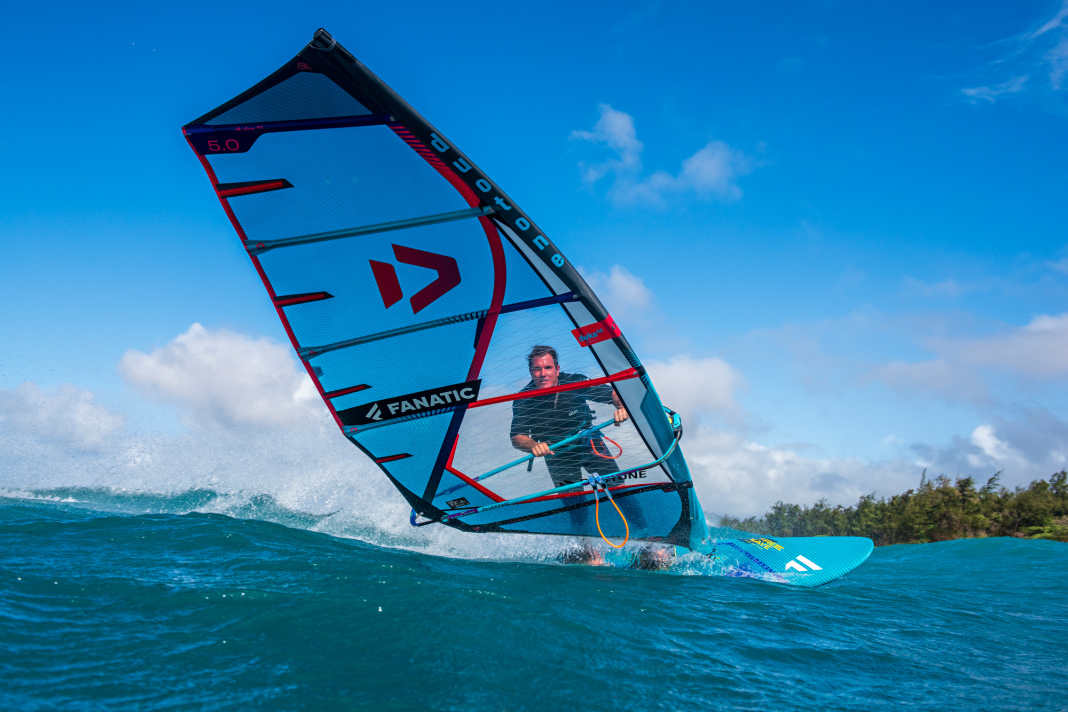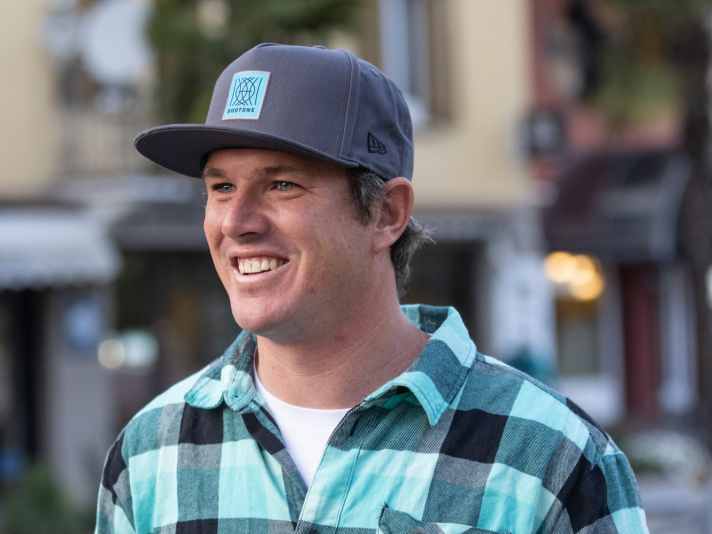



The name Duke reappears in your 2023 range, but the Super Session disappears...
We want to keep it as simple as possible for the customer by having the Super Hero for wave and then the Duke as an all-round sail for bump & jump. If there are too many sails in the range, then it becomes a bit too complicated for the customer. Raoul Joa, our Product Manager, gave us the order: we need a bump & jump sail with five battens for a freeride customer who is coming from a no-cam sail and needs a high-wind sail.
So this is a completely new development, right?
Yes, that was quite funny. Raoul said it's really easy: just take the Superstar HD, add a fifth batten and you're done. We did that as a test and I went out on Maui with a 5.0 at 30 knots - and didn't even get planing. You can see again that a sail needs real development. And that's why we took two years to develop it in peace and quiet. Before we start, I usually sit down with Kai Hopf(Duotone sail designer, editor's note.) together and we think about what are the goals, what do we want to achieve? Of course, we won't get the same planing performance as with a four-batten sail, but it should be similar. We then played a lot with the batten position. We call this the "batten free centre", we have built in a large gap between the lower batten and those above it so that the sail has more space to load up, and then you also get a similar planing performance to a four-batten sail.
Is the characteristic the same for all sizes?
The aim was to have an all-round sail across all sizes, from 4.2 to 6.7, i.e. bump & jump, a bit of wave, a bit of freestyle...of course the larger sizes are a bit more geared towards straight-line heating. Our Austrian windsurfing legend Chris Sammer is always a bit lazy when it comes to his sails. He could get all the sails, but he only ever takes the Duke. For wave riding, a bit of freestyle and for heating on Lake Neusiedl - the sail covers everything. He only wants to set up one, the boards are changed, but he only ever uses one sail. That was also important to us, that we create a sail that covers a broad market.
What was in the specifications, what did it absolutely have to be able to do?
These were planing, stability and easy handling. Easy handling is always at the top of my list, no matter what kind of sail. Whether racing, wave or freeride. When I developed the Warp Fin, the team riders always wanted the fastest sail. However, I always said that we would endeavour to achieve the simplest and lightest handling. As a result, the guys said that the sail was so easy to ride, they could close their eyes and just concentrate on the race. And since then, easy handling has been my top priority. Because then it's stable, it's easy to ride and also suitable for the customer. That's why the pressure point is relatively far forward, like on a freeride sail, so that everyone can find their way around immediately. It's always important for us to say that a customer coming from the E-Pace can't just go straight to the Superhero because the pressure point is completely different and they won't feel comfortable there straight away. It is important to us that the customer who buys a new sail always feels the same. That's why we aimed for the same pressure point as a no camber sail, so that he jumps on it, it pulls him forwards and he simply feels comfortable.

Who else was involved in the development?
That was actually just me (laughs). Normally I always try to incorporate feedback from the team riders. With the Duke it was completely different, we mainly developed it on Maui and on Lake Garda, and I often went to customers on Lake Garda and told them to try out the sail. They're delighted, it's a real highlight for them when they can try out a white prototype and give feedback! And that was also important for me, what does a real customer feel who perhaps only goes surfing once or twice a year? Is this the right product for them? And that was also really interesting for me, I had a lot of conversations and tried to incorporate that into the product. I also used a lot of sails at the Duotone Pro Centre, and I would say that the customers and I developed the Duke.
The name Duke has been around before and is still well known to many. What's behind the fact that you've brought it out again?
I think it's always good for marketing if you pick up on older names that you have fond memories of. I can still remember standing my first Spock with a Duke, that was my favourite sail, it was the first new sail I bought. And then I said, why don't we bring it back? It still has a good image, many people still talk about it. And so we thought, let's just bring the Duke back! But that's why it was important to us that the sail was really good and not just any old sail, which is why we tested it intensively for two years. I also gave it to the team riders again later, as I always have to make sure that everyone likes it, not just me.
With you, Duotone and Fanatic, more and more of the old names have been coming back for a few years now. Which legend do you want to revive next?
I don't know anything yet (laughs). Of course, it's possible that something will come up again. We simply see that many windsurfers who have stopped in the meantime are coming back to the sport, and of course we want to show them: Look, here's the Duke or the Eagle again, they were here before. They also have fond memories of them. Launching a completely new name is always more difficult, you have to come up with a bang, a highlight product. And that's why we always favour old names that already have a certain image.
Are these newcomers and people who primarily want easy surfing also the primary target group?
Over the last few years, I've simply realised - and now I've also seen it at the surf festival on Fehmarn - that as an industry we can't just focus on performance, we also have to focus on the average customer. We want to make it as easy as possible for the customer. Not just on the water, but also when setting up, so that it's easy and understandable, and that they then have fun. There are customers who perhaps only go surfing once a year, they go to Lake Garda for a fortnight and that's it. And it's important to us that they have fun during those two weeks. And that they don't have to worry about how exactly I have to trim the sail, how do I have to sail so that it works well? It should be as simple as possible. That's why we brought out the Eagle, which is very easy to sail, and now the Duke.
Did you specifically work towards making the sail easy to trim and perhaps forgiving of minor mistakes?
In my active time, I usually spent a year fine-tuning, regardless of whether it was a wave or racing sail. The customer simply doesn't have time for that. At Duotone, we also have the dots in the top that show how far you have to trim the sail. Then we have a slit at the bottom of the sail where you can see the extension and mast exactly, so you can mark the position when you have found a good trim and then find it exactly the next time you set it up. We've also had the forks with VTS Tail for a year now. I think the customer can do a lot more wrong with the clew tension. Many pull far too hard at the rear, which always makes me feel a bit sick. If you tighten it too much, you can also "trim the sail to death". Many people also think the wind is getting stronger, so I pull more at the back to have more control. That's completely wrong. And that's why we have a system on the clew where you can use the markings on the rope as a guide, for example three markings for light winds and five markings for strong winds. This allows us to show the customer roughly how to trim their sail so that they can have fun. When I see people pulling their sail totally flat, I always try to explain that you need a certain amount of suspension in the sail, otherwise it feels very stiff and you lose control with every gust. You need a certain volume in the sail. And with these features we want to help customers a bit, make it easier for them and give them the expertise that we have gathered over time.
Keyword simplification: Do I absolutely have to have the right mast for the Duke or is it also tolerant of other makes?
The customer will always get the best performance with a mast from the same brand, as we also carry out the development on our masts. That's why we offer different masts in different price segments, but in the end the customer will still get the right performance from the sail, even with the cheaper option. I always try to explain to customers that the mast is the most important part of the sail. Sometimes it is better to invest more money in the mast than in the sail. That is why it is advisable for the customer to decide in favour of one brand.
You'll soon find out whether the Duotone Duke fulfils its promises here - the sail is already ready for testing!
Technical data Duotone Duke & Duke HD
- Sizes:4,2/4,5/4,7/5,0/5,4/5,8/6,2/6,7
- Luff: 380/390/404/412/434/440/452/466
- Fork: 154/158/164/166/170/178/182/190
- Masts: up to 5.8 RDM, 6.2 RDM or SDM, 6.7 SDM
- more info: duotonesports.com

